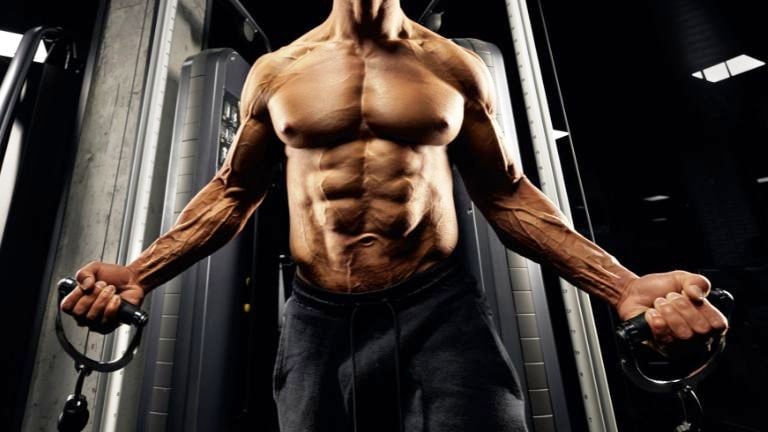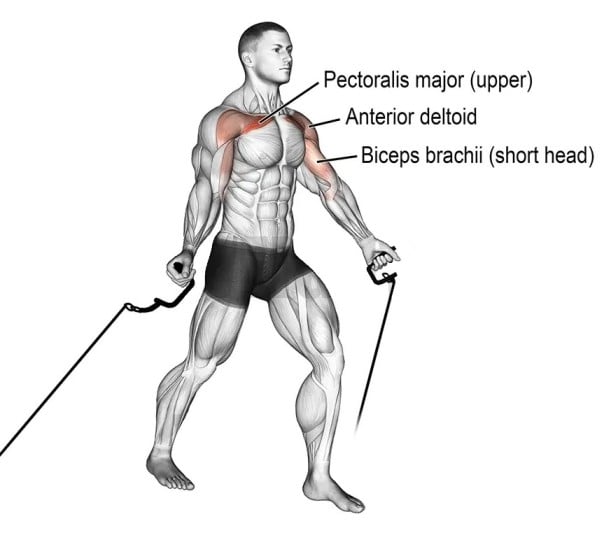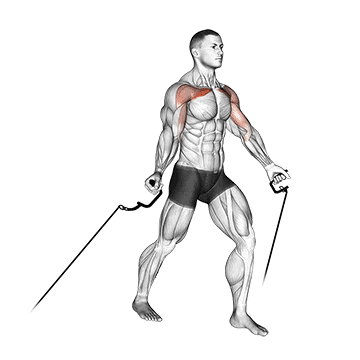Have you ever felt like your upper chest needed a little more push during your workouts? Then, low-to-high Cable fly is a great option.
It is also known as low cable fly, and it is one of the best chest exercises for training the chest at various angles and strengthening the chest and shoulders. It primarily targets the upper pectorals by pulling the arms from a low to high angle.
This exercise is highly specialized in isolating the pectoral muscles. Unlike compound exercises such as bench presses, which target the chest, triceps and shoulders, the low Cable Chest Fly solely targets the chest.
This cable fly variation is a good way to build strength and size in the pecs when working on the upper chest area.
The cable setup allows for a wider range of motion than some other exercises, allowing the chest muscles to stretch and contract more fully. This increases chest development and flexibility.
Want to take your gains to the next level? Discover your daily calorie needs with our free TDEE calculator

Low Cable Chest Fly Muscles Worked
The low to high cable chest fly primarily works the pectoralis muscles, specifically the upper chest muscles.
Low Cable fly involves several synergist muscles, including rhomboids, levator scapulae, anterior deltoids, and latissimus dorsi. The biceps brachii, brachialis, brachioradialis, and Triceps also assist.
A handful of other muscles also serve as stabilizers, including the wrist flexors, obliques, and rectus abdominis.

How To Do Low To High Cable Fly
- Adjust the pulleys to the lowest position on both sides.
- Attach handles to the cable pulley at the bottom.
- Grasp the cable attachments in each hand using an overhand grip.
- Initiate the movement by pulling the handles upward and inward in an arc motion.
- Keep your elbows fixed in place as you bring the handles up and together over your chest. Focus on flexing the chest.
- Move your hands upward until they are above your chest and the cables cross over.
- Pause and squeeze the chest in the fully contracted position.
- Slowly return to the starting position by resisting gravity in a controlled motion. Do not let the arms drop.
- Repeat for desired reps and sets. Typically, it is in the range of 8-15 for muscle hypertrophy.
Tips And Properly Form
- Maintain a slight bend in the elbows. Do not fully lock out the elbows.
- Keep your torso stable and core engaged. When you bring the handles forward, avoid excessive arching of the lower back.
- Move the handles in an arc-like motion in front of your body, rather than straight out to your sides. This arc targets the pecs better.
- Keep your feet shoulder-width apart or in a staggered stance for better balance.
- Squeeze your chest hard at the peak contracted position before slowly returning to the starting position. Hold for a second to maximize muscle tension.
- Use a controlled motion on both the concentric and eccentric parts of the movement. No jerky momentum.
- Go through a full range of motion for maximum chest muscle activation.
- Breathe out as you raise the cables and squeeze. Inhale as you return to the starting position.
- Keep your head neutral and your eyes focused forward to help maintain proper alignment.
- Use lighter weights and higher reps to practice nailing down form before increasing the load if needed.
- Occasionally, perform the exercise in front of a mirror or film yourself to ensure your form is correct.

Benefits Of Low To High Chest Fly
- Specifically targets the upper portion of the pectoral muscles (clavicular head).
- Cables provide continuous resistance throughout the movement that offers consistent muscle activation.
- Enhances muscle separation and definition in the upper chest region.
- Help improve muscular balance and symmetry in the chest by targeting the upper chest muscles.
- It helps strengthen stabilizing muscles around the shoulder joint, potentially reducing injury risk.
- Strengthens chest and anterior shoulder muscles, promoting better posture.
To Stay Motivated: 150+ Gym Workout Motivational Quotes To Stay Fit

Manish is a NASM-certified fitness and nutrition coach with over 10 years of experience in weight lifting and fat loss fitness coaching. He specializes in gym-based training and has a lot of knowledge about exercise, lifting technique, biomechanics, and more.
Through “Fit Life Regime,” he generously shares the insights he’s gained over a decade in the field. His goal is to equip others with the knowledge to start their own fitness journey.
